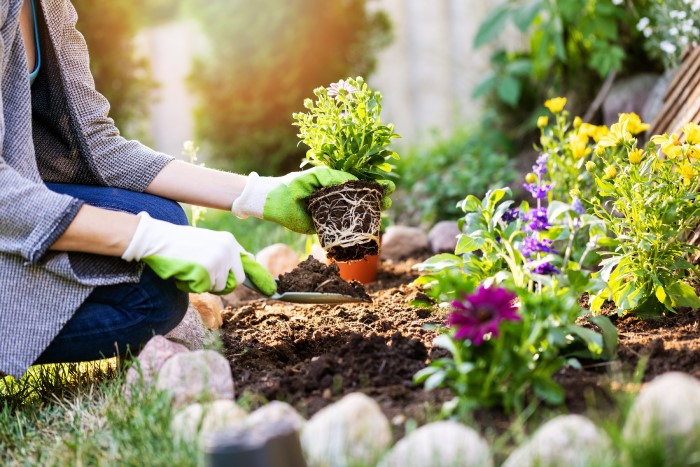Spring is the ideal time to freshen up your garden. Be proactive when maintaining your garden. This way it will remain vibrant, healthy, and beautiful throughout the year. We’ve prepared a spring gardening checklist. It covers everything important that you should attend to. Following our checklist will keep your outdoor space in great shape. Who wouldn’t want a beautiful outdoor area that blooms year-round? The checklist was created with input from knowledgeable landscapers.
Table of Contents
Spring Gardening Checklist
You have most likely prepared a spring cleaning checklist for your house already. Don’t forget about the garden, though! It needs some love too. Especially as the weather warms up. This helpful guide will ensure you don’t miss anything. It will also prepare your outdoor space for all of the fun events with your loved ones.
1. Soil Preparation
Let’s kick off your spring garden TLC by getting the soil ready for some serious planting action! First up, clear out any bits of debris or old plant stuff that might’ve built up over the chilly months. Then, grab a garden fork or tiller and give that soil a good fluff-up to help it breathe and drain better. Toss in some organic goodies like compost or aged manure to give your soil a tasty nutrient boost and help it hold together nicely. Oh, and don’t forget to check the pH levels of your soil and tweak them if needed. Your plants will thank you for setting up their ideal growing environment!
2. Planting and Transplanting
Spring is the ideal season to get your garden in shape! It’s a good idea to get new plants or move around existing ones. Gather some high-quality plants from reputable nurseries or garden centres. Consider factors including soil requirements, growth potential, and sun exposure. For variety, get a combination of trees, shrubs, bulbs, perennials, and annuals. Remember to pay attention to planting guidelines. Consider how deep and wide they will grow. Give them a good amount of water and some mulch after planting. Doing so will help them to establish. Also, watering them keeps weeds from taking over.
3. Pruning and Trimming
Pruning and trimming are super important. This practice keeps everything healthy and looking good. Examine your perennials, shrubs, and trees. Look for any branches that are dead, damaged, or simply too large. Trim those back. It will help them grow nice and strong, and keep their shape in check. Also, don’t forget to snip off any old flowers or leaves. This will promote blooming and stop diseases from spreading. Use sharp and clean cutting tools. It is best to cut at a 45-degree angle. This method reduces harm and allows plants to recover more quickly.
4. Fertilising and Feeding
Let’s make sure your plants are getting all the goodies they need to be happy and healthy! Grab some balanced, slow-release fertiliser for your established green pals. Just check the package for how much to use and how often. Choose eco-friendly fertilisers if you are environmentally friendly. Another option is to create a compost tea. Each of the options will be good for the soil. Make sure not to overuse the fertiliser. It can mess up the balance of the soil. It’s also bad for the environment. Monitor plant growth and adjust the fertilising routine when needed.
5. Mulching and Weed Control
Lay organic mulch to garden beds, trees, and plants. Use wood chips, straw, or shredded bark. Mulch keeps moisture in place, regulates soil temperature, and prevents weed growth. Monitor mulch depth regularly. Add more if needed to maintain a thickness of 2-3 inches. Scan your garden for weeds and remove them promptly. Take them out by hand. You can also use appropriate gardening tools. Keeping your garden weed-free will prevent competition for resources and maintain a tidy appearance.
6. Watering and Irrigation
Make sure your plants get enough water. It is super important for keeping them healthy. This is because the weather becomes warmer in spring. Rain also becomes inconsistent. Water your plants deeply but not too often. This helps their roots grow nice and strong. This also makes them better at handling dry spells. Use a watering wand, drip irrigation system, or soaker hose to hydrate the plants. It is vital that water reaches the plant roots. You should ideally water in the morning. This is because the weather is still cooler. The water won’t evaporate as quickly. You will also reduce the chance of plants getting infected by fungal diseases. Observe the weather. Also, constantly check the health of your plants. Adjust how often you water if needed.
7. Pest and Disease Management
Look out for any signs of pests or diseases in your garden. Be proactive and stop them in time. Keep a close eye on your plants. Things to look out for are: leaves turning yellow, chewed foliage, or weird growth patterns. To avoid those issues, try planting in different locations each year. Also, give your plants enough space. Keeping everything nice and clean is also important. When it comes to dealing with pests and diseases, lean towards using organic methods or stuff that’s not too harsh. Hand-pick bugs off your plants, use special soaps made for insects or spray botanical solutions. That way, you can solve the problem easily. This way, you will also be friendly to the good bugs and critters in your garden.
Conclusion
Our checklist will help you lay the foundation for a pretty landscape. Your garden will thrive year-round. Follow these essential tasks. You will surely create a vibrant and healthy outdoor space. The outdoor area of your home will bring joy and beauty. With proper planning, attention to detail, and regular maintenance, your garden will flourish and evolve with each passing season. By staying proactive you ensure that your outdoor area remains beautiful and enjoyable for activities and relaxation.

